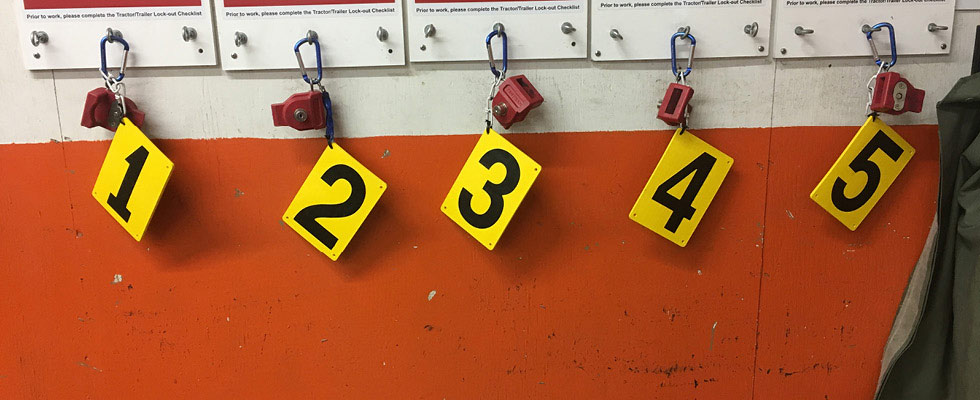
Thousands of propane fueling stations operate across the United States. Small gas stations and grocery, hardware and convenience stores provide propane tank refills to businesses and families in many communities. The tank refills not only involve replenishing grill canisters, but also all types of portable cylinder sizes including those for generators, campers, lawn mowers, patio heaters, building equipment, motor homes and propane-fueled vehicles.
The challenge there is inherent danger and potential liability for self-service fueling stations where customers may come into close contact with the flammable gas. Since all tank refills must be performed safely and correctly, this requires permanent signage that warns customers, personnel and the public to avoid hazardous actions, such as smoking or using matches nearby.
To ensure safety and compliance in a flammable propane dispensing environment, identification products such as safety signs and valve tags are critical to efficient operation, as well as maintenance and repair.
For example, a sign can warn, “Danger! No Smoking Within 25 Feet,” and a no trespassing sign can caution, “Do Not Enter. Authorized Personnel Only.” Other signage can provide critical safety instruction, such as indicating the location of the “Emergency Shutdown.”
Likewise, valve tags on the propane tank — such as “Monitor,” “Control” or “Bypass” — are essential for any operator to safely dispense the gas, as well as quickly respond to prevent a problem from becoming an emergency.
All of these brief warnings or instructions, comprised of letters, numbers and symbols, must effectively convey key information to customers, personnel and the public. This is crucial to protect the industry from the risk of injury and litigation — as well as quickly identify the type of equipment, which is essential in the event of an emergency.
In addition, signs displaying emergency contact numbers and procedures must be prominently displayed where appropriate to ensure a quick, effective response to emergencies. These signs provide information on how to contact local emergency services and other relevant authorities in the event of an incident.
Traditionally painted and laminated identification products can fade or delaminate when continually exposed to outdoor weather or punishing conditions. Solar ultraviolet (UV), rain, snow, ice and windblown debris — as well as humidity and seasonal temperature fluctuations — inevitably degrade these identification products in a matter of years.
Over time, outdoor exposure can cause painted and laminated numbers and symbols to peel or fade. Even products designed for this purpose can become unreadable after 10 years.
Given what is at stake, the industry is now increasingly shifting to identification products designed to withstand decades of abuse without becoming unreadable.
Safety Signage Must Last
When it comes to crucial safety signage, the legibility of typical identification products may become degraded over the years. The paint will fade, and the laminate will peel on these products usually within five to 10 years, compromising legibility and requiring a necessary replacement.
Yet inspecting and replacing illegible products seldom — if ever — occurs on a comprehensive and timely basis because it can be a time consuming, laborious process that is shortchanged in deference to higher priorities. Neglecting to do so, however, can lead to dangerous safety lapses as well as inefficient operation.
Designed for Enduring Safety
So, how can safety signage be designed and constructed to ensure readability after decades? The answer requires a shift in thinking. For long-lasting applications with critical safety requirements, impermanent paints and laminates should be avoided in favor of more durable solutions. The signage should also be constructed using robust substrate or embossed characters that can take a beating from Mother Nature.
As an example, one type of sturdy signage system developed for the industry is made of thick, high-impact polyolefin plastic with copy and pictograms that are permanently embedded through the entire thickness of the substrate. The polyolefin plastic is impervious to sun, wind, rain, humidity, saltwater and temperature variations as well as fumes and acid or alkali solutions. The characters can be seen from a distance and have sharp contrast. The signage can be cut, scratched and even shot through with little or no effect to the embedded characters, which helps to ensure readability decades later.
Third-party certification validates the durability of this approach. UL performed numerous durability tests on the signs in compliance with UL and ASTM standards. When the signs were subjected to the equivalent of 43 years of UV exposure, salt spray, vibration, abrasion and temperature variation, the test results showed no change in color or legibility of the signs.
Another highly effective and proven method of creating permanent signage is to use embossing. Embossing creates raised characters in metal materials to improve legibility even when covered in dust, dirt or paint.
For tight, confined spaces where close reading is required — such as valve tags — miniature markers with raised, 3D characters can also be designed to remain legible even in low light, oily or dusty environments. The raised, 3D characters are hot stamped with high-quality, UV-stable foil and are nonconductive and noncorroding, which is ideal for environments exposed to water.
No Replacing Physical Signage
Another compelling reason these identification products need to last decades is they are sure to remain valuable tools for propane stations as new technologies for asset management and maintenance are employed.
Although propane stations have long used identification products, the possibility that critical information could become obscured or unreadable in a matter of years is no longer acceptable as a standard. Even when not strictly mandated, industry professionals who opt to use innovative products designed to last for many decades can significantly improve safety and uptime and concurrently reduce potential liability and litigation risk.


